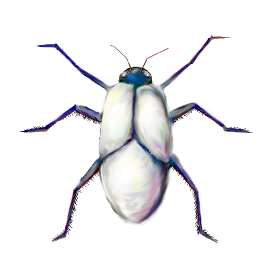Mirrorback beetle
From Wikimalia
(re-posting) |
|||
| (5 intermediate revisions not shown.) | |||
| Line 1: | Line 1: | ||
{{Collection-Bugs | {{Collection-Bugs | ||
| - | |image= | + | |image=Mirrorback Beetle.png |
|name=Mirrorback Beetle | |name=Mirrorback Beetle | ||
|habitat= Fresh water shorelines. | |habitat= Fresh water shorelines. | ||
| - | |description= Shaped cleverly like a dewdrop, this iridescent silver beetle's wings reflect almost all light. Barely half the size of a leklek's fingernail, one might overlook it were it not for the shining shimmer given off, even in dim light. Six feathery legs appended with tiny hooks support the body, although it is difficult to tell the front of the insect from its rear. | + | |description= Shaped cleverly like a dewdrop, this iridescent silver beetle's wings reflect almost all light. Barely half the size of a [[leklek]]'s fingernail, one might overlook it were it not for the shining shimmer given off, even in dim light. Six feathery legs appended with tiny hooks support the body, although it is difficult to tell the front of the insect from its rear. |
|collection= | |collection= | ||
|notes= It has been speculated that this bug's overt appearance may, like the color red in other species, be a warning that it is either unpleasant to the taste or toxic to predators. Once thought to be the source of quicksilver (mercury), they are highly prized by collectors. | |notes= It has been speculated that this bug's overt appearance may, like the color red in other species, be a warning that it is either unpleasant to the taste or toxic to predators. Once thought to be the source of quicksilver (mercury), they are highly prized by collectors. | ||
}} | }} | ||
| + | The perennial mirrorback is a typical summer bettle, seeking warm hiding places in winter, often beneath the bark of trees or near humanoid habitats. This latter tendency makes them welcome or unwelcome, varying by culture. Salamae tend to view them dimly, as on occasion, they do bite, and their most common victims are curious children. Their bite is mildly painful, but otherwise harmless.<br> | ||
| + | Trullocs regard them as harbingers of weather, using their hibernation cycles as accurate forecasters of the severity or mildness of the coming winter, whereas talayi simply find them aquatically appealing, appearing as dewdrops where none are present.<br> | ||
| + | The mirrorback beetle's diet is mainly aphids, so their presence is often regarded as beneficial by gardeners. Tending to cluster in small swarms, the beetles may take flight simultaneously if startled, and many can attest that the sparkling display of so many reflective wings at once can seem nearly magical.<br> | ||
| + | |||
| + | {{stub}} | ||
| + | Back to the [[Insect/Arachnid]] page. | ||
Current revision
| The Bug Collection | ||||||||
|---|---|---|---|---|---|---|---|---|
|
| ||||||||
| ||||||||
The perennial mirrorback is a typical summer bettle, seeking warm hiding places in winter, often beneath the bark of trees or near humanoid habitats. This latter tendency makes them welcome or unwelcome, varying by culture. Salamae tend to view them dimly, as on occasion, they do bite, and their most common victims are curious children. Their bite is mildly painful, but otherwise harmless.
Trullocs regard them as harbingers of weather, using their hibernation cycles as accurate forecasters of the severity or mildness of the coming winter, whereas talayi simply find them aquatically appealing, appearing as dewdrops where none are present.
The mirrorback beetle's diet is mainly aphids, so their presence is often regarded as beneficial by gardeners. Tending to cluster in small swarms, the beetles may take flight simultaneously if startled, and many can attest that the sparkling display of so many reflective wings at once can seem nearly magical.
This article is a stub. You can help Wikimalia by expanding it.
Back to the Insect/Arachnid page.

